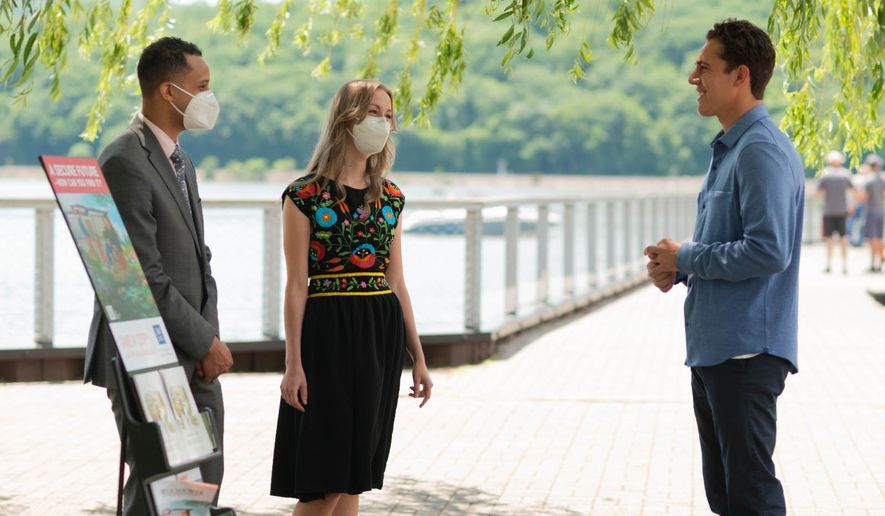The 1.3 million U.S. members of Jehovah’s Witnesses are returning to street-corner evangelism this week after more than two years of pandemic-enforced isolation, including literature displays near The White House and in New York City’s subways.
Their familiar door-to-door canvassing won’t resume immediately, a spokesman added, but Witnesses will visit those who request contact in their homes. The group is evaluating a return to widespread doorknocking, however.
The group shut down in-person contact on March 23, 2020, as the COVID-19 pandemic gripped the world, Witnesses’ spokesman Robert Hendriks said in a telephone interview.
While proper masking and vaccinations make it safer to approach people, he said the group is taking a cautious approach.
“We’re not walking down streets and knocking on every door. We’re going basically to those who have expressed interest, those we have Bible studies with,” he said. “It’s a progressive opening of our ministry.”
The church restarted in-person services in April.
SEE ALSO: Conservatives say parents have right to know their child’s pronouns at school
Going house-to-house, Mr. Hendriks said, is something the Witnesses trace back to the New Testament, specifically in Acts 20:20. The Witnesses began “zealously preaching” door-to-door in 1919 through 1922, and met opposition from towns and cities that tried to outlaw the practice.
That opposition was finally surmounted in 2002 when an 8-1 Supreme Court majority ruled an ordinance in Stratton, Ohio, requiring canvassers to obtain a permit from the village’s mayor, was unconstitutional on religious free exercise and free speech grounds.
But what a village’s lawmakers couldn’t halt, COVID-19 did. The Witnesses resorted to letter-writing, telephone calls and electronic measures such as email and video meetings to spread their message. In April, the group resumed in-person meetings, and returned to the streets earlier this month after determining such outreach would be safe.
“We understand the disease a lot better,” Mr. Hendriks said. “We know that it doesn’t have to be deadly. We understand that there are vaccines and boosters available that we know are effective, and people now have a choice to take those.”
He said masking and the availability of “therapeutics” for those who’ve been infected after vaccination also make the situation different from 2020. The spokesman said Witnesses believe they have a duty to show up on people’s doorsteps.
“We have an obligation to knock on their door, that is our Christian obligation,” Mr. Hendricks said. “We do it because we love our God and we love our neighbor. But we also recognize that that obligation is contingent upon the fact that our neighbors feel comfortable in us coming. And at this point, we’re not sure that we’re there yet.”
The literature carts were adopted as an outreach method by Jehovah’s Witnesses in the U.S. in 2011, a news release indicated, although commuters in New York’s Port Authority Bus Terminal had been greeted by a literature table from group members since at least the late 1970s.
The carts have since popped up at airports, harbors and even national parks and historic sites.
Mr. Hendricks said the return of Witnesses to public outreach has been welcomed by non-believers.
“When we went back in the subways in New York City, just a couple of weeks ago, when the [Metropolitan Transportation Authority] workers saw us they all gave us a round of applause,” he said. “The New York City Police Department, many of the street cops went up to our brothers and sisters who [were] setting up their carts, and they said, ‘Thank you for coming back.’ Because we’re a peaceful presence in those areas that have experienced turmoil.”
Not every organization once noted for door-to-door canvassing is rushing to return to your front steps, however.
Since 2005, missionaries of the Church of Jesus Christ of Latter-day Saints, popularly known as the Mormon church, have shifted much of their effort from unannounced visits to more tech-friendly outreaches such as blogs, text messages and social media, the Salt Lake Tribune reported last year.
An LDS Church spokesman said via text message that the traditional image of two proselytizers at the front door “had been really minimized long before COVID.
“In some locations it may return on a limited basis but … the door-to-door contacting has not been what traditionally it was, even though there’s likely a lot of folks who associate that with missionaries still today,” the spokesman said.
• Mark A. Kellner can be reached at mkellner@washingtontimes.com.




Please read our comment policy before commenting.